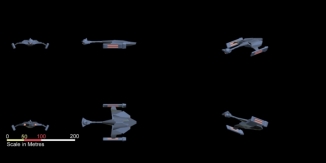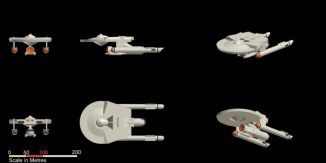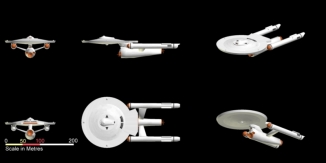| Details to follow
|
||||
| Class: | TBC | Year: | 2254 | |
| Ship Source: | Based on D-7 | Ship Datasheet: | Coming Soon | |



| Class: | VIII | Year: | 2254 | |
| Ship Source: | FASA | Ship Datasheet: | Coming Soon |
The D-9 cruiser was brought into service during the Four Years War to act as a research vessel. For years, the Klingon Empire had been halted in its attempts at expansion. To the rimward lay the Federation; towards the trailing arm were the Romulans; and it has been speculated that to the core-ward lay some unknown power able to hold the Klingons in check. This left the spinward area, as yet not fully explored. Expansion into this void had been slow due to the great distances from the homeworld of Klinzhai and the apparent lack of suitable worlds for conquest, but the desire to outflank the Federation altered that. The newly constructed D-9 cruiser was intended to lead this effort.
The D-9A prototype of 2254 was considered to be undergunned and was dropped from production even before it had been commissioned. An upgunned version, the D-9B with mainly defensive weaponry, was commissioned in 2255 and was immediately sent into the new expansion area. These ships and their accompanying scout ships were to map new areas and evaluate the cultural levels of any races encountered. The war with the Federation ended one year after the D-9B’s entered service, and the sense of urgency for the flanking expansion effort diminished. The flanking movement is portrayed in a Star Fleet commanders test known as Operation Armageddon.
After the end of the Four Years War, most of the facilities set up to produce these research cruisers were converted over to warship designs, accounting for the small number produced. The D-9, named “Seeker” from the Klingon “z’gal”, is manufactured at Gnuu Re, with production at three per year. These vessels are still operating in the spinward areas. Of the 82 D-9’s built, 68 remain in active service, 9 have been destroyed, 3 are listed as missing, and 2 have been sold to private interests in the Triangle.
| Class: | VIII | Year: | 2252 | |
| Ship Source: | FASA | Ship Datasheet: | Coming Soon |


The Four Years War saw the need for large number of escort cruisers to be quickly commissioned. The Achernar and Tikopai classes of supplemental cruisers met this need. The Achernar class was adapted from the mark two versions of the standard Ptolemy (Achernar Mark 1) and Keppler (Achernar Mark 2) classes of Transport Tug. The Tikopai class was adapted from the mark two versions of the Dollond (Tikopai Mark 1) and Doppler (Tikopai Mark 2) classes. All four of these tug classes were in both Starfleet and Civilian service, and ships originally destined for civilian lines were diverted to this program.
The supplemental cruisers were created by the addition of a specialist pod with a hanger, enhanced sensors and weapons. The mother ship itself was unchanged, except for the impulse drive if it required upgrading and retained its own light weapons fit. This solution meant large numbers of the supplemental cruisers could be built quickly, as the Tugs were already mass produced in civil yards, and the weapons hull could be easily built by the smaller warship builders. These ships, although underpowered, were an invaluable asset in convoy escort duties throughout the war. Post-war these ships were all swiftly de-commisioned and converted to standard tug configuration, and then either sold off for commercial transport use, or used to replace wartime tug losses in the fleet.
The weapon pod contained 8 FL-4 Lasers in 4 banks, with 2 banks covering each arc of fire, a pair of FAC-3 accelerator cannons was positioned on the sides of the pod to fire forward. These ships provided a valuable role escorting convoys, often hiding amongst innocent looking standard configuration tugs to lure attackers in. The main criticism that could be levelled at both of the classes was the weak shielding systems, but the adoption of more advanced shielding systems would have prevented the construction of the ships in civilian yards.
| Class: | V-VI | Year: | 2253 | |
| Ship Source: | Franz Joseph Designs/FASA | Ship Datasheet: | Download PDF | |
| The design is based on the FJ tugs, the name is from FASA to provide a way for these classes to serve in the four years war prior to the commissioning of the heavy cruisers. | ||||


From Star Trek Expanded Universe:
The USS Ares (NCC-1650) was the prototype of the Ares-class. It was commanded by Garth of Izar during the Four Years War. (Star Trek: Axanar)
During the first two years of the four years war, Starfleet was experiencing near constant defeat at the hands of the Imperial Klingon Navy’s D-6 battlecruiser. Whole systems were being seized, with the populations slaughtered at their hands. Changes needed to be made to save the Federation. The Starfleet Commander in Chief, Admiral Conrad Slater, was replaced by Admiral Marcus Ramirez. Ramirez’s first action was ordering the design and production of the Ares-class. The simulations showed promise, but its first real test would be on the battlefield. The Vulcans restricted their involvement to environmental, propulsion, and defensive sytems, though there were voices that demanded Vulcan remove their participation completely. In the words of Admiral Samuel Trask, “A Vulcan’s gonna do what a Vulcan’s gonna do. But the Andorians… they were happy to supply us the phasers.” The first ship in the class, the USS Ares, would be assigned to the Captain of the Destroyer Xenophon: Captain Kelvar Garth. There were over a dozen other member worlds waiting on the Ares class. Operation Pegasus would be the proving ground.
On stardate 2244.1, the Ares took part in its first combat engagement near the planet Cygnus III during Operation Pegasus. (“Prelude to Axanar”). In the words of the Supreme Warlord of the Imperial Klingon Navy (“Kharn the Undying”), “The new class Starfleet vessels were… unexpected.” Kelvar Garth, pushing his vessel’s capabilities to the maximum, surprised the Klingons and delivered a victory to Starfleet at Cygnus III. Following those events, Starfleet would go on to regain much of their lost territory. The USS Ares was faster, more agile, more heavily-armed than any operation Klingon vessel. With the new Ares-class and with the hard-won experience of their battle-tested commanders, three systems were retaken within 30 days. The Klingon ship captains began to give the Federation their due as a worthy adversary, primarily taking notice of Garth of Izar. The Captain of the USS Hercules, Samuel Trask, was quoted as saying, “That mad Izarian son of a bitch – that was his day.” Captain Sonya Alexander of the USS Ajax added, “Garth likes to play down what he did. Don’t you believe it. What he did that day no Starfleet Captain had ever done.”
In total 12 Ares class ships were built, production was curtailed in favour of additional ships of the Constitution class and related designs. The Constitution class was marginally cheaper and quicker to build, was more combat efficient, and it was recognised it would be a more a versatile design to retain postwar.
9 of the Ares class ships survived the war, and post war they served as guard ships for key installations before being mothballed in 2262. All were recalled for service in 2267 when the fleet was put on a war footing prior to the Organian conflict, after the imposition of the treaty the ships returned to reserve.
| Class: | IX | Year: | 2254 | |
| Ship Source: | Star Trek Axanar | Ship Datasheet: | Coming Soon | |
| NB The write up of the Ares creates an issue in that it clearly states that the design is a product of the four years war, but at the same time places the first Constitution class ships under construction (which is 9 years too late). I have chosen to keep the wartime date and ignore the Constitution reference. | ||||


“The USS Moscow and the other ships of this class were the one of the last major classes without dilithium. The immediate predecessor to the Constitution class, the Baton Rouge class exhibited the distinct separated living disc and engine modules so familiar now. Up-rated in the 2250s, these ships have only recently completed their commissioned usefulness as interstellar carriers.”
The uprating was due to delays in the Constitution program, and introduced new warp engines, impulse engines, weapons and shields. In this configuration the ships gave valuable service in the four years war.
The Mark 1 Baton Rouge class entered UFP service in 2225 and were the last major cruiser class built with non dilithium energised engines, in total an impressive 86 Mk1 ships was built over 18 years. A modification program in the 2240’s saw 40 of these ships re-equipped with new M- 1 computers, enhanced weaponry and unary shield generators to become Mk2s, a further 14 ships were built as new to compensate for delays in the Constitution programme. This modification meant that the ships remained a useful element of the fleet despite their low top speed compared to newer design.
In 2254 the damaged Mk2 USS Britannia was refitted to Mk4* standards at Utopia Planitia. The secondary hull of the Britannia was damaged beyond repair, and it was decided to use a secondary hull from a written off Heston Class Cruiser. The refit was based on the standard Mk4 for spares support reasons, except the heavy FAC-4 replaced the FAC-3, one pair of these were mounted in the traditional location on the saucer below the bridge, and a second pair atop the secondary hull. The resulting ship was designated a special type and entered service providing heavy support to the 35th Cruiser Squadron (which consisted of Mk3/4 Baton Rouges). Further production of the Mk4* was not authorised as the type’s range was reduced compared to that of the standard Baton Rouge, and the cost of the refit in time and resources was deemed prohibitive compared to the Mark3/4 refits.
In 2256 the Britannia was ambushed while protecting a convoy of troopships in supposedly safe territory. She single handledly managed to hold off three D-10 cruisers while the convoy escaped to safety escorted by another pair of ships from the 35th CS. In total the convoy was carrying over 100,000 troops and Captain Kelsey of the Britannia felt that it was more important for the two other cruisers to safeguard the convoy then to help hold off the D-10s. Miraculously 150 of the Britannia’s crew, including Captain Kelsey, managed to survive the battle, and all three D-10s were crippled or rendered ineffective.
Britannia’s battle was not yet over though, a trio of Orion Pirate vessels attracted by the potential for booty and salvage moved into attack. The crew aboard the damaged Britannia managed to get their accelerator cannons online, and when the lead Orion vessel, a captured D7, moved into the arc of fire they hit it with all four cannons destroying the Orion Vessel, the resultant explosion damaged the second Orion cruiser, but also mortally damaged the unshielded Britannia. The third Orion vessel was destroyed when the command pod of one of the D-10s separated and rammed it’s warp nacelle. The crew of Britannia were forced to abandon their ship as the damage sustained in this final battle caused a catastrophic impulse reactor explosion. The surviving crew members being rescued by the Klingons who they had been fighting just an hour earlier. Aboard the Klingon vessels the survivors were welcomed as warriors with honour, it was not lost on the Klingon commander, Gorkon, that the Britannia could have evaded combat and left the Klingons at the mercy of the Orions.
| Class: | X | Year: | 2254 | |
| Ship Source: | Space Flight Chronology/ FASA | Ship Datasheet: | Download PDF |

You must be logged in to post a comment.